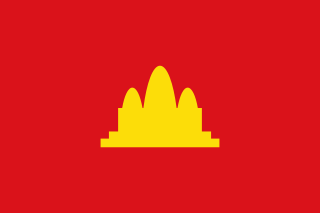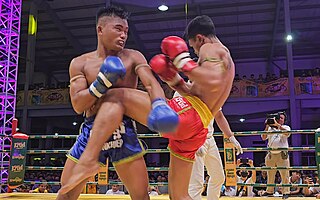The history of Cambodia, a country in mainland Southeast Asia, can be traced back to Indian civilization. Detailed records of a political structure on the territory of what is now Cambodia first appear in Chinese annals in reference to Funan, a polity that encompassed the southernmost part of the Indochinese peninsula during the 1st to 6th centuries. Centered at the lower Mekong, Funan is noted as the oldest regional Hindu culture, which suggests prolonged socio-economic interaction with maritime trading partners of the Indosphere in the west. By the 6th century a civilization, called Chenla or Zhenla in Chinese annals, firmly replaced Funan, as it controlled larger, more undulating areas of Indochina and maintained more than a singular centre of power.

The Khmer Rouge is the name that was popularly given to members of the Communist Party of Kampuchea (CPK) and by extension to the regime through which the CPK ruled Cambodia between 1974 and 1979. The name was coined in the 1960s by then Chief of State Norodom Sihanouk to describe his country's heterogeneous, communist-led dissidents, with whom he allied after his 1970 overthrow.

Throughout Cambodia's long history, religion has been a major source of cultural inspiration. Over nearly three millennia, Cambodians have developed a unique Cambodian culture and belief system from the syncreticism of indigenous animistic beliefs and the Indian religions of Buddhism and Hinduism. Indian culture and civilization, including its languages and arts reached mainland Southeast Asia around the 1st century AD.

Pradal Serey or Kun Khmer is a combat sport that originated in Cambodia. The official Khmer name of the sport is Kbach Kun Pradal Khmer. In Khmer, pradal means fighting or boxing and serey means free. Thus, pradal serey may be translated as "free fighting" or "free boxing". The sport consists of stand up striking and clinch fighting where the objective is to knock an opponent out, force a technical knockout, or win a match by points.

Islam is the religion of a majority of the Cham and Malay minorities in Cambodia. According to Po Dharma, there were 150,000 to 200,000 Muslims in Cambodia as late as 1975. Persecution under the Khmer Rouge eroded their numbers, however, and by the late 1980s they probably had not regained their former strength. In 2009, the Pew Research Center estimated that 1.6% of the population, or 236,000 people were Muslims. Like other Muslim Cham people, those in Cambodia are Sunni Muslims of the Shafi'i denomination and following the Maturidi doctrine. Po Dharma divides the Muslim Cham in Cambodia into a traditionalist branch and an orthodox branch.

The Khmer people are an Austroasiatic ethnic group native to Cambodia. They comprise over 90% of Cambodia's population of 17 million. They speak the Khmer language, which is part of the larger Austroasiatic-language family alongside Mon and Vietnamese.

The Killing Fields are a number of sites in Cambodia where collectively more than 1,000,000 people were killed and buried by the Khmer Rouge regime during its rule of the country from 1975 to 1979, immediately after the end of the Cambodian Civil War (1970–1975). The mass killings were part of a broad state-sponsored genocide.

Buddhism in Cambodia or Khmer Buddhism has existed since at least the 5th century. In its earliest form it was a type of Mahāyāna Buddhism. Today, the predominant form of Buddhism in Cambodia is Theravada Buddhism. It is enshrined in the Cambodian constitution as the official religion of the country. Theravada Buddhism has been the Cambodian state religion since the 13th century. As of 2019 it was estimated that 97. 1 percent of the population are Buddhists.

François Bizot is a French anthropologist. While working as a conservationist in Cambodia, he was held captive by the Khmer Rouge for several months. He was released after being found innocent of spying charges, becoming the only Westerner to survive imprisonment by the Khmer Rouge.

Kampuchea, officially known as Democratic Kampuchea from 5 January 1976 onward, was a one-party totalitarian state which encompassed modern-day Cambodia and existed from 1975 to 1979. It was controlled by the Khmer Rouge (KR), the name popularly given to the followers of the Communist Party of Kampuchea (CPK), and was founded when KR forces defeated the Khmer Republic of Lon Nol in 1975.

The Bunong are an indigenous Cambodian ethnic minority group. They are found primarily in Mondulkiri province in Cambodia. The Bunong is the largest indigenous highland ethnic group in Cambodia. They have their own language called Bunong, which belongs to Bahnaric branch of Austroasiatic languages. The majority of Bunong people are animists, but a minority of them follows Christianity and Theravada Buddhism. After Cambodia's independence in 1953, Prince Sihanouk created a novel terminology, referring to the country's highland inhabitants, including the Bunong, as Khmer Loeu. Under the People's Republic of Kampuchea (1979-89), the generic term ជនជាតិភាគតិច "ethnic minorities" came to be in use and the Bunong became referred to as ជនជាតិព្នង meaning "ethnic Pnong". Today, the generic term that many Bunong use to refer to themselves is ជនជាតិដើមភាគតិច, which can be translated as "indigenous minority" and involves special rights, notably to collective land titles as an "indigenous community". In Vietnam, Bunong-speaking peoples are recurrently referred to as Mnong.

The Extraordinary Chambers in the Courts of Cambodia, commonly known as the Cambodia Tribunal or Khmer Rouge Tribunal (សាលាក្ដីខ្មែរក្រហម), was a court established to try the senior leaders and the most responsible members of the Khmer Rouge for alleged violations of international law and serious crimes perpetrated during the Cambodian genocide. Although it was a national court, it was established as part of an agreement between the Royal Government of Cambodia and the United Nations, and its members included both local and foreign judges. It was considered a hybrid court, as the ECCC was created by the government in conjunction with the UN, but remained independent of them, with trials being held in Cambodia using Cambodian and international staff. The Cambodian court invited international participation in order to apply international standards.

Youth in Cambodia make up 65.3% of Cambodia's 14,805,000 people. Twenty-six percent of Cambodians are between the ages of 14 and 30 and another 30% are under 14. All of the youth in the country are second and third generation offspring of survivors of the Khmer Rouge, a genocide that occurred from 1975-1979. Roughly 20% of the population resides in its cities, mostly in Phnom Penh, the capital.

Marriage in Cambodia is a social institution which structures Khmer society. The Khmer wedding, with its long history and rich symbolism, is also famous for its specific music, known as phleng kar.

The Cambodian genocide was the systematic persecution and killing of Cambodian citizens by the Khmer Rouge under the leadership of Communist Party of Kampuchea general secretary Pol Pot. It resulted in the deaths of 1.5 to 2 million people from 1975 to 1979, nearly a quarter of Cambodia's population in 1975. It is an example of democide.

The effects of genocide on youth include psychological and demographic effects that affect the transition into adulthood. These effects are also seen in future generations of youth.
The Truth and Reconciliation process in Cambodia refers to efforts to create other truth-seeking and reconciliation mechanisms in the country, in addition to the hybrid tribunals established by the Cambodian government and the United Nations in 2001.
Traditional Cambodian medicine comprise several traditional medicine systems in Cambodia.
The koan kroach is an esoteric Khmer amulet made from mummified fetuses "obtained from the forced removal of the fetus from a wife in her first pregnancy".
A neak ta is a Cambodian ancestral or tutelary deity, believed locally to watch over people, places, and things, as long as they are paid proper respect.












